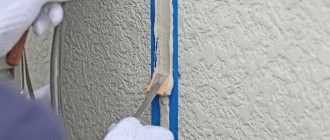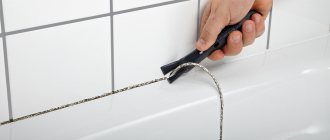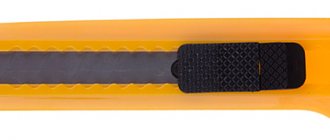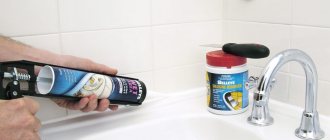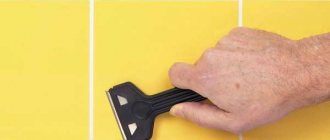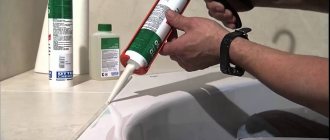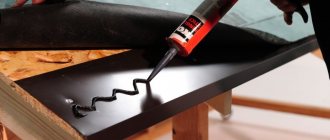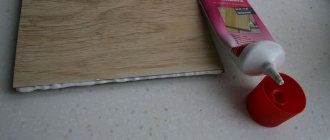Types of solvents
When choosing a particular means for diluting hardened sealant, it is important to take into account some features of its composition. Silicone-based mixtures are divided into three main groups.
Silicone-based mixtures are divided into three main groups.
- Acid based.
Acetic acid is used to make this type of silicone solution. This material has a low price and a not very pleasant smell. The composition is incompatible with some metals and marble. - Alkali based.
This type of mixture is made on the basis of amines and, as a rule, has a specific purpose. - Neutral.
They are considered universal compositions that are suitable for almost all materials.
On the modern building materials market you can find special impregnations for diluting sealant. However, folk remedies are no less effective and will help in a situation where there is no special-purpose composition at hand.
Available means
The use of folk remedies for diluting the sealing composition is convenient primarily because solvent mixtures can be found in almost every home. If there is a need to wash off the sealant that has not yet hardened, you can use ordinary water and a rag. This method is suitable only when more than twenty minutes have passed since the application of the mixture.
Minor traces of the sealing agent can be removed using gasoline or kerosene. Silicone mixtures can also be treated with acetone or acetone-containing solutions.
Special formulations
One of the popular means for liquefying silicone sealant is Penta-840.
. This solution is suitable for application to almost any surface. The disadvantage of the mixture is its high cost.
The process of diluting silicone sealant at home with Penta-840
pretty simple. It is necessary to apply the solution to the area that needs to be cleaned and leave for the time indicated on the product packaging. After which the softened silicone can be easily removed from the surface.
Quilosa Limpiador cleaner can be used to soften fresh sealant.
. The product is suitable for all types of hard surfaces.
Permaloid _
is an ideal option for removing hardened sealing layers from plastic. It does not dissolve plastic and does not leave any marks on the material. The cleaner is also used to clean metal surfaces and car parts.
Dow Corning OS-2 Cleaner
Designed for cleaning surfaces before subsequent treatment with paints, sealants or glue. The product is safe for human health and can be used to clean surfaces that come into contact with food.
Paste for removing hardened silicone Lugato Silicon Entferner
Suitable for the most sensitive surfaces. The product can be used to clean painted structures, wood, natural stone, tiles, and so on. The mixture does not spoil the structure of the material and does not affect the color and gloss of the surface.
Silicone Remover
comes in gel form and is designed to liquefy hardened silicone.
The mixture is universal for all materials. The only requirement for the surface to be treated is that it must be completely dry. Silicone Remover
is characterized by its high speed of action on cured silicone sealants. It is enough to hold the solution on the dirt for ten minutes, after which the sealing mass can be easily removed.
Silicone and liquid state
Silicone-based sealant can be diluted or diluted with several substances. The main thing is that the sealant retains its properties. It is prohibited to use toluene for these purposes - silicone is not a harmless substance, and in combination with toluene it leads to chemical poisoning.
Construction gun for easy application of sealant
You can not lose quality and dilute the silicone to a liquid state using silicone rubbing. It is important to maintain the proportion: 1: 6 – rubbing: construction silicone.
You can also dilute the sealant with silicone oil or lighter gasoline. It's better to use the first option.
Special means
If it was not possible to dissolve the sealant with a universal solution, there are several special products that will help cope with the problem. Their action is based on the destruction of silicone polymer chains. The price of such compositions is higher than simple solvents, but they have a gentle and effective effect without damaging surfaces. Any special product will dissolve even old glue.
Remover Penta 840
"Penta 840" is a destructive remover. It refers to products that completely dissolve silicone. Before work, you need to carry out a test application to avoid damage to the surface. The technique for working with the wash is as follows:
- apply to a layer of silicone;
- wait until it becomes soft;
- Clean the resulting gel with a soft cloth;
- Wash off any remaining residue with a weak solution of vinegar or lemon juice.
Dowsil OS-2
Dowsil OS-2 is produced as a liquid that evaporates instantly. It contains methylsiloxane. It is gentle on plastic and painted surfaces without dissolving them. They wash off fresh and hardened glue. You can also dilute the frozen silicone that is in the tube with Dowsil. To process, you need to spray the liquid, wait until the silicone softens and remove it with a soft cloth.
KUDO product
This is a soft aerosol that contains non-aggressive solvents. It removes residual sealants and can be used on any surface.
Mellerud
Mellerud is based on acid. It is used to process tiles, wood and glass. Before starting processing, the hardened glue is cut off with a sharp knife. The product is applied and left on the surface for 1 to 12 hours, after which the softened gel is removed.
HG product
HG is a universal composition. All surfaces are treated with it. Application time can range from half an hour to 10 hours. This depends on how hard the glue is. The kit includes a brush and spatula, which can be used to conveniently remove the softened gel.
This sealant solvent is used for the following materials:
- plastics;
- enamels;
- ceramic coatings;
- glass products;
- wooden elements;
- concrete and brick.
The product is not suitable for marble and non-ferrous metal products. If the surface is painted, Lugato can only be used after a preliminary test.
Body Antisil 770
It contains organic substances that have a gentle effect on surfaces. It can be used for all metal coatings (aluminium, stainless steel, chrome). "Body Antisilom" removes silicone from glass and glass-ceramic surfaces
When processing plastic, you must be careful and do not proceed with application without first testing it. If the product consists of polyethylene or fluoroplastic, the product cannot be used
Body Antisil 770 is used when treating an automobile component, removing old sealant and gaskets from it.
Even those who are far from construction work know the fact that polyurethane foam is an excellent building material...
Many solvents and special products contain acetic acid, but using it as an independent solvent is ineffective.
Silicone removal process
Almost all solvents are similar in the process of interaction with the sealant. Since the composition has an aggressive effect on the surface and humans, they take care of their safety. Provide good ventilation, wear gloves and a respirator. Before use, try the effect on a sample. When the check is completed, proceed to the following steps:
- The selected product is applied to the contaminated surface. The manufacturer indicates the application method on the solvent. To do this, use a washcloth or apply the product to the stain.
- The instructions indicate the time of exposure to the solvent, it is maintained. It varies from 1 to 24 hours depending on the degree of drying.
- The contamination turns into a gel-like state, after which it is removed. Most often, a dry cloth is used for this. But there are exceptions to the rules. Using “Silikill”, dissolved dirt is removed with a damp, soapy cloth.
The solvent acts faster if the dissolution procedure is performed in a dry room. Remove the remaining aggressive composition with a damp sponge. This procedure is mandatory, otherwise solvent residues will continue to corrode the coating or get on the skin. After cleaning, the work area is ventilated.
Before looking for a means to dissolve silicone sealant, ask yourself the question of feasibility. There is no point in removing frozen sealant on a plasterboard sheet, since this will soften the material itself that is being puttied. If the drop is large, then it is cut off at the root and then hidden under a layer of plaster.
Acesolve PUN is a solvent for removing polyurethane and butyl tape based sealants from the surfaces of conveyor equipment, sealing tables, and sealing equipment. General use.
AcesolvePUN is a slow evaporating sealant. Compared to the quickly evaporating sealant, methylene chloride, it has a number of advantages in terms of durability. Since AcesolvePUN exhibits a strong solvent effect on plastics, paints, seals, stamps, we recommend a compatibility test before use. Teflon based materials such as Kalrez* and Zalak* are solvent resistant materials, rubber and Viton can be dissolved with AcesolvePUN.
AcesolvePUN has been tested and approved by renowned insulating glass manufacturers.
Specification
pH (conc.): 5 - 8
Density: 0.830 – 0.870g/ml
Refractive index: 1.423 – 1.447
Application.
Uncured sealant residues are easily removed by AcesolvePUN. It is also used to clean mixer (mixing machine) parts, including mixer hoses and gun. The degree of cleaning depends on the curing state of the polyurethane sealant. A fully cured sealant will not dissolve in any solvent, it will only swell.
Because AcesolvePUN evaporates very slowly, any remaining solvent should be removed by blowing with compressed air or thorough cleaning before using sealing equipment.
Removing different types of sealants
The most effective way is, of course, special solvents. But their choice is so wide that it will be difficult for the average person to understand which one he needs. Silicone solvents come in the form of:
- Liquids.
- Pastas.
- Spray.
Which type to choose depends on the specific case. There is also a special one on sale, which is made from organic thinners. It has a number of advantages, since it can be used at different temperatures. The wash does not lose its properties even after freezing and thawing, so storing it is much easier.
If you read the composition of sealant solvents, it will become obvious that they are different. How do you know which one to choose? The fact is that silicone also has more than one chemical base. It is made to be used in a variety of conditions and on a variety of surfaces. Here are the main types of sealants:
- Acidic. The most common and cheapest. They are made on the basis of acetic acid. This is very noticeable when working, as the strong smell of vinegar spreads. These sealants have limitations in their use. They interact chemically with non-ferrous metals and oxidize them. It is also not recommended to use them with materials containing cement, as an alkaline reaction occurs.
- Neutral. They cost much more, but are also more versatile. They are usually made on an alcohol basis. There is no pungent odor when using. Can be used with any metals without fear of oxidation. There will be no problems with cement materials either. They have increased water resistance, due to which they are used even in shipbuilding and aircraft construction.
- Alkaline. Narrow-profile amine-based sealants are practically not used in everyday life. When working, they emit the smell of stale fish. Purpose – work with non-ferrous metals, marble, as well as materials containing cement.
When the composition has been studied, a sealant solvent suitable for its chemical properties is purchased. The dissolution process is done in a pre-prepared container
It is important to do everything in a dry room for the best effect. After adding the mass, wait the time specified in the instructions for the solvent, usually up to several hours.
It should be noted that the silicone will not become completely liquid. It will be jelly-like, like a mush.
Acetic acid
It is important not to confuse it with vinegar, which is essentially diluted acid to the desired concentration. Suitable as a solvent for acidic silicone
If you've ever had to dilute wallpaper glue, the principle here is similar. Acid is gradually added to the sealant and the whole mixture is stirred. This is done until the required consistency is achieved.
Petrol
The one that is sold not at gas stations, but in hardware and construction stores. It is a perfectly purified fuel with a higher octane content than regular gasoline. Moreover, the octane number is not constant and changes slightly. Gasoline for lighters is also suitable.
Prepare a container in which the silicone will liquefy. The sealant is squeezed into it and gasoline is gradually added, which will dissolve the contents to a “sour cream” state.
Silicone oil
Silicone lubricants and wipes are also suitable. To liquefy, you must maintain the proportion. To one part of oil or grease, add six parts of silicone. Everything is mixed until a homogeneous substance is obtained. The advantage of this method is that after transitioning to a liquid state, silicone does not lose its original properties.
White Spirit
To obtain liquefied alcohol-based silicone sealant at home, regular white spirit will also work. To begin with, select a bottle of suitable size. Solvent is poured into it. After this, the silicone is squeezed out of the tube. Close the bottle and shake for five to ten minutes. If necessary, add a little white spirit or sealant, it all depends on the required consistency.
A selection of solvents for diluting chemical-based sealants
A modern effective means for sealing seams and joints between tiles and an acrylic bathtub after renovation is completed is silicone sealant. To remove excess it, it is necessary to dissolve it with a thinning agent and then remove it without destroying the surface layer of the tile. It is necessary to observe the established proportions when preparing the composition at home.
The appearance of the sealant resembles mastic with a transparent color. It is made on the basis of flowing rubber, which penetrates into inaccessible places, resulting in maximum tightness. Over time, it hardens, the level of protection against moisture increases, and the thermal insulation qualities improve. It is also used against mold, thereby protecting against the destruction of plaster in the bathroom. When deciding the issue of removing excess sealant, you need to take into account its features.
There are two types of solvent compositions. In household use, one-component solvents are used. In industrial conditions - two-component. To use silicone bathtub sealant at home, you need to dissolve it. According to its properties, the material belongs to vulcanizing substances and is divided into two types:
- Acid.
- Neutral.
Created on the basis of acetic acid, the first type of solvent emits a specific odor when polymerization is carried out. Sealant of this class is inexpensive, but incompatible with some materials. It is not recommended to use it when working with marble, materials containing cement, or non-ferrous metals that are subject to corrosion. For these purposes, an amine-based alkaline profile sealant is used, but only in industry: it is not used in everyday life due to its specific odor, reminiscent of rotten fish.
Sealant solvents include acetic acid, which dilutes acidic silicone. The sealant gradually dissolves with the added portion; this must be done by thoroughly stirring to bring it to the desired consistency. The principle is similar to preparing wallpaper glue. Silicone acid sealant softens when you add concentrated 70% vinegar essence to it. The product enters into a chemical reaction with non-ferrous metal, oxidizing it. Material containing cement causes an alkaline reaction.
The neutral type of sealant solvents is alcohol-based. It is considered more universal, its cost corresponds to the quality. The product is compatible with different surfaces and does not have a strong odor. Due to its increased water resistance, it is applicable to any metals; oxidation does not occur. Used in shipbuilding and aircraft construction. The following neutral solvent compositions give good results:
- oxide;
- amine;
- alcohol composition (alcohol sealant dissolves under the influence of alcohol).
In other cases, neutral silicones for dissolution should be used:
- acetone;
- White Spirit;
- refined gasoline.
Alcohol-based sealant is dissolved with white spirit in everyday life. To dissolve silicone sealant, you need to take a bottle of suitable size, fill it with solvent and squeeze a portion of silicone out of the tube. Then close the lid tightly and shake the container for 10 minutes - during this time the components are brought to the desired consistency.
Special means
In case of repair work, you should immediately resort to household chemicals to quickly dissolve the silicone sealant and begin the main repair. This will significantly save time and effort.
The procedure is similar for all types of washes:
- Cut off part of the silicone, leaving no more than 2 mm (as a rule, this is required when the material is accidentally spilled on a surface other than the one being glued).
- Allow the reactions to pass. As a result, the glue softens to a gel-like state and loses most of its adhesive properties.
- Remove the residue with a spatula, dry cloth or other tool.
- Degrease, removing any remaining cleaner and preparing the surface for a new seam.
TOP effective remedies against silicone sealant:
- Tytan is the most popular solvent presented by the Polish brand Selena. The wash is packaged in an 80 ml syringe, which is not very convenient, but quite suitable for work. The product takes from 20 minutes to 3 hours to deal with the glue, but the result is justified: the residue is removed easily, without effort. The main disadvantage of the product is its pungent odor, which requires good ventilation or an exhaust hood.
- Silicone Remover from the Belgian company Soudal is a mid-priced cleaner. 100 ml costs an average of 300 rubles. Includes spatula and brush. However, buyers do not respond very well to the wash. There is a low-quality spatula, which is not enough for the whole job, a strong smell of the cleaner and its low efficiency.
- HG is one of the best silicone caulk removers. Container - 100 ml, a spatula and a brush are included, which are enough to apply the remover and remove the glue. In 30 minutes, the seam is so corroded that it can be removed even with a simple napkin. At the same time, buyers note a pleasant smell.
- Kudo is a cheap anti-silicone product, 520 ml costs only 150 rubles. However, the downside is high consumption and relatively low efficiency.
- Auster Silicone Cleaner is the 5th most popular silicone and mold cleaner. Belongs to the middle category and costs 200 rubles. for 60 ml. It copes well with silicone sealant; after half an hour the material can be removed with a spatula without effort.
- Mellerud is another widely used mid-priced product with approximately the same characteristics as Auster.
Characteristics
Plastic and soft in structure, silicone is made from a solid material – silicon. It determines the properties of the sealant:
- Elasticity. It is not destroyed by mechanical stress and compensates for deformation, therefore it is used in movable joints;
- High tear resistance;
- Wide temperature range. Properties are maintained in the range -50 – + 200 °C;
- Resistance to external influences: detergents, humidity, temperature changes, UV, bacteria, fungi.
Silicone sealant
The properties of silicone sealant are improved by adding substances:
- Organic extenders – reduce viscosity;
- Mechanical fillers – improve adhesion. Glass, quartz dust and chalk are often used;
- Fungicides – provide resistance to mold and mildew;
- Dyes.
But the opposite need may arise - removing the sealant. When sealing joints and cracks, sealant often gets on there, thereby worsening the appearance. Therefore, the question becomes relevant: how to dissolve silicone sealant? The properties of the material make removal difficult. If a thick layer of sealant is noticed in time, then it is carefully pryed over the edge with a thin knife and pulled. While still plastic, the sealant can be removed easily. But more often you have to remove the frozen silicone applied in a thin layer. You can't do this without chemicals.
Applying sealant
Solvent selection
When choosing a silicone solvent, you need to consider its type. He can be:
- universal;
- sanitary;
- aquarium;
- automobile.
In addition to the type of sealant, you also need to take into account where the building material was used. The fact is that silicone is not always used for its intended purpose.
In addition to removing silicone sealant from places where it should not be, it may sometimes be necessary to dissolve cured building material
If the sealant has just been applied and has not yet hardened, it can be removed with a clean napkin. It must first be moistened with water. If more than 20 minutes have passed, the removal procedure will be more difficult.
It is necessary to understand that not all remedies will be equally good. Many chemicals can easily remove excess silicone, but they can ruin the product or damage the skin.
A glass surface stained with silicone can be cleaned with white alcohol. There is also a special product that is designed to remove sealant without causing damage to other materials - Penta-840. A small amount of solvent is applied to the problem area and after the time specified in the instructions for use, it is removed along with the softened silicone. But the special solvent has a significant drawback - high cost. It is for this reason that many builders, when choosing how to dilute silicone sealant, prefer cheaper options, which include gasoline or kerosene. Their effectiveness will be slightly lower, which will require more time to solve the problem, but it will be possible to remove excess silicone from the glass.
If the sealant has just been applied and has not yet had time to harden, it can be removed with a clean napkin.
When silicone gets on the tile, previous chemical solvents may not be suitable if the quality of the finishing material is low. Otherwise, the aesthetic qualities of the material being cleaned may be damaged. The use of organic solvents is most suitable, i.e. kerosene or gasoline.
To prevent the glossy side of the tile from becoming scratched after removing excess silicone, it is not recommended to use products that contain abrasive particles. It is for this reason that it is better to use a soft cloth when removing sealant.
If, during installation of the sink, liquid silicone was applied in large quantities and smeared the countertop, then in order to get rid of it you need to be patient. Some surfaces are resistant to various aggressive substances. In this case, the solution will be simple - white alcohol or a special solvent. When there is a risk of ruining the countertop, you need to mix gasoline with dishwashing detergent and apply it to the dried silicone. After some time, the structure of the sealant will become softer and you can try to separate it from the surface.
Countertops that cannot withstand prolonged exposure to moisture will have to be cleaned mechanically or put up with an unsightly stain of silicone sealant. To minimize the risk of surface damage, removal is best done with a wooden kitchen spatula.
The use of special washes with wipes
You can dissolve or dilute sealant with a silicone base using other means while maintaining its properties. Silicone rubbing is used to turn it into a liquid state without losing quality. The proportion established by the building standard is one part rubbing or lubricant to six parts building silicone. It is imperative to comply with the requirements of the standard to obtain high quality. To obtain a homogeneous substance, you need to mix everything. The advantage of this method is that silicone in a liquid state retains its original properties.
To quickly clean silicone from tiles, enamel, metal, and polyvinyl chloride (PVC) surfaces, you can use ready-made products:
- Silicone remover Penta-840 - under the influence of low temperatures it does not lose its characteristics.
- The commercially available Antisil solvent softens the sealant layer on rubber gaskets.
- Silicon-Entferner.
- Silicone Remover - when used, the shine is maintained and the surface does not become matte.
How to remove the drug
Considering that after polymerization the product adheres firmly to the base, the easiest way is to cut it off or scrape it off. This is only possible for rough surfaces that are not afraid of abrasives. It is better not to clean glossy and smooth coatings in this way, because they can be damaged. For mechanical cleaning, you can use any sharp and thin instrument:
- Metal spatula. A narrow model is optimal. It will be convenient to pry off the frozen silicone and remove it. Important point. The edge of the spatula should be intact. If there are nicks, it will be useless and even dangerous for the appearance of the base, since it will scratch it.
- Knife, stationery or shoe. Both options are good, but the first one is quite fragile, so it needs to be handled carefully. With their help, you can trim the dried mass and remove large sagging.
- Unnecessary bank card. An excellent tool that will not scratch the base. It is optimal to use soft plastic after preliminary dissolution of the product. It will not cope with hard material.
Instagram instabur.pro
To remove the sealant without damaging the surface, you can use a soft plastic spatula. Another great tool is an unnecessary bank card.
In order to wipe off the remaining dried paste, abrasives are used. The simplest one is table salt. This is a gentle product that can be used on tiles or glass without worrying about scratching. Harder abrasives are steel wool and pumice. They are used where the coating cannot be scratched.
Other effective thinners
The sealant is also diluted using silicone oil. When working with such solvents, the shine of the tiles decreases and the color tone of the surface changes.
It is necessary to take into account the density of the cohesive chemical base of the sealant. The silicone will not soften immediately; it takes some time for it to become watery - then it can be used.
The glue must be dissolved to a watery state at home with gasoline. The composition will provide the effect if you get it in hardware or construction stores. You should use fuel that is refined with the highest octane, unlike regular gasoline used at gas stations.
The octane number is not constant and can change. It is acceptable to use gasoline in lighters.
From the sides of the bath
This takes into account the material from which the bath is made. It can be acrylic, cast iron, steel. Acrylic bathtubs require special treatment. To clean silicones, you must use only factory-made solvents that are marked with permission to use on such bathtubs.
Do not clean acrylic trays, shower cabins and bathtubs using rough materials - emery cloth, steel wool, brush, etc. Organic solvents are also prohibited.
Steel and cast iron bathtubs are less capricious and can be easily removed from the sealant using abrasive materials and chemicals. But you can’t be overzealous here either - there is a risk of scratches.
How to restore a bathtub without extra costs, read the article Restoring a bathtub with your own hands.
Instructions for cleaning steel and cast iron bathtubs mechanically:
- using a blade or a special knife, cut off as much of the top layer of sealant as possible;
- the residues are scraped off with a plastic spatula or steel wool;
- pumice or sandpaper with small grains will help get rid of marks.
After the manipulations done, greasy stains often remain. They can be easily removed with a slab cleaner. You can use baking soda, but it will take longer to clean.
For the chemical method, a solvent is used, which is applied to the sealant seam. After a day, such a strip can be easily removed using a spatula or wooden spatula. The fatty layer is removed with alcohol-containing liquids.
There is another way to remove silicone between the bathtub and the wall. To do this, you need to arm yourself with a screwdriver or scissors. You should start from the edge of the bathtub. In this place, use the sharp edge of the tool to pick up the sealant. Next, without sudden movements, pull it around the perimeter.
If there are any remaining areas of silicone, you can cut them off with a knife and then work with pumice.
Penta-840 and the Permaloid series - what is their characteristic?
If you are confused and don’t know how to remove silicone-based sealant, the Penta-840 remover will help you, which effectively removes silicone residues from a variety of surfaces (metal, cast iron, tiles, concrete, stone, glass). What are the advantages of this wash? It does not lose its qualities due to temperature changes and will withstand frosts, which increase its shelf life. Penta-840 dissolves fully hardened silicone-based sealant. The remover contains no chlorine or fluorocarbons.
How is the product used? Moisten a rag or cloth well with the remover, apply it to the area contaminated with silicone and cover the top with polymer ethylene. This will help eliminate vaporization, aiding faster penetration and breakdown of polymer materials. The exposure time depends on the layer thickness and is specified by the manufacturer.
After the procedure, we remove the remains of the sealant, wipe the cleaned area with soapy water, let it dry, if necessary, use a hairdryer. If the remains of Penta-840 cannot be completely washed off the surface, we recommend using acidified water with the addition of lemon juice or table vinegar. We wet a rag in the resulting solution and walk it over the dirty area.
Solvents for removing silicone-based sealants
And in order not to have to wonder for a long time whether the selected remover for silicone is suitable for your surface, the German company Spies Hecker has released a linear range of Permaloid solvents for removing silicone-based sealant:
- Permaloid 7799 – for car metal parts;
- Permaloid 7799 – for plastic surfaces;
- Permaloid 7989 – for removing sticky residue from paint surfaces and guns;
- Permaloid 8510 – used as an additive that prevents the formation of silicone craters;
- Permahyd 7080 new – suitable for cleaning fiberglass, metal and paint coatings.
Removing sealant from plastic
It is easiest to wipe off silicone from plastic, since its adhesion to this material is the weakest. Pipes, plastic shower cabins, acrylic bathtubs and trays can be washed by first moistening the sealant with solvent (30-60 minutes). The remaining traces are washed off with any degreasing composition. However, such a simple process of removing old silicone is only possible if no primer was used during application. Its use greatly complicates the task. Firstly, it is more difficult to select the appropriate solvent, and secondly, you will have to combine softening the silicone and mechanical cleaning.
Dow Corning OS-2 has worked well for removing sealant from plastic surfaces. It does not damage plastic and is suitable for both acrylic surfaces and ordinary plastic pipes. Step-by-step instructions on how to remove sealant from an acrylic bathtub:
- Apply the solvent to the silicone and wait until it softens;
- use a plastic or wooden spatula to pry off the remaining sealant and remove it;
- wipe off the remaining mark with a rag and degrease the surface.
How to clean silicone grout in the bathroom?
White spirit, gasoline, acetone or vinegar will help remove dried silicone from the bathtub. Lubricate the defective area - after a while it will be enough to wipe off the dissolved composition. Rub the remaining marks and stains thoroughly with fine table salt or dishwashing powder, then rinse with hot water.
Interesting materials:
Why is steel hardened? Why do you add soda to flour? What is egg melange used for? What is iambic used for? What is menovazine used for? What is solvent used for? What is Svetets used for? What is balsamic used for? What is wood used for? What is an action camera used for?
Adviсe
To remove silicone and acrylic, follow these tips:
- Heating. This method will quickly get rid of stains on any surface. To do this, the contaminated area is moistened with vinegar, then a paper sheet is applied, which is ironed with a hot iron.
- Freezing. To implement this method, the item is placed in the freezer, the time for complete freezing is waited, and the stain is removed with a sharp object.
- Minor stains can be wiped off with hydrogen peroxide.
- No pollution allowed. The work must be done with gloves and work clothes. Apply masking tape near the area to be treated.
We recommend watching the video instructions:
How to remove silicone and acrylic sealant
The most reliable way to remove silicone and acrylic sealant from various planes is to combine mechanical and chemical methods.
From the bath
To remove the old seam between the wall and the bathroom, you need to prepare a sharp knife, salt, a washcloth, and a solvent.
Use a knife to cut a seam in the middle. This will make the process much easier and faster. By hooking it from below, the entire tape is removed. The remaining traces are washed with salt and a sponge, then wiped with a rag soaked in solvent.
If the marks are fresh, then vinegar will help wash off the silicone sealant. Once the stain has hardened, apply vinegar overnight.
When using an acrylic surface, care should be taken as it is more susceptible to mechanical damage. For cleaning, a wooden or plastic scraper is used and the products are applied for no more than 15 minutes.
From tiles
It is easier to remove acriplast from tiles. It has a smooth surface and is not so whimsical. The sealed mass is removed with a knife. If you are afraid of scratching the tile, then it is better to remove it with a razor. Then use a rag soaked in gasoline or kerosene to wipe the contaminated area until the layer softens. If softening does not occur, then use white spirit or Penta-840 (a destructive remover that completely dissolves silicone).
From plastic
The adhesion of acriplast to plastic is not maximum, so removing it will not be difficult. Any solvent is applied to the surface for an hour, then the molten mixture is washed off with a rag and soapy water.
When removing sealant from shower stalls where a specialized adhesive sealant was used, it is necessary to use special products such as Dow Corning OS-2. It is designed to soften hardened sealant and remove silicone adhesive. Its composition is completely harmless to plastic surfaces.
From glass
Glass planes are most often removed from sealants. To clean them, we use the mechanical method of cutting with a razor or knife and wiping with a solvent.
Gasoline should not be used as a cleaning agent, as it leaves rainbow stains on the surface.
From clothes
If acryplast gets on clothing, it is removed immediately by prying the stain from one edge with a sharp object. When soaking the mixture into the fabric, you should moisten the stain with vinegar, wait, and do a normal wash.
Some types of sealants can be removed with alcohol. You can wet the brush with it and clean it. Under the influence of alcohol, the mass rolls into small pieces.
From hand
Salt will help remove silicone sealant from your hands. To do this, warm water is poured into a small container and salt is added. Hands are placed in salt water, waited 5 minutes, and cleaned with pumice. The procedure is repeated several times, since initial complete removal will not occur.
Also, instead of salt water, wash in water with laundry soap.
How to dissolve silicone substance at home?
Sealant is a substance that is used to seal joints on various coatings. Treatment with the product does not allow liquid to penetrate inside. The material is based on rubber and a number of special additives. Liquid in composition, silicone glue hardens a few minutes after application.
Removing durable material is not an easy task, as when it hardens, the substance turns into a monolith. The sooner you start getting rid of impurities, the better the result will be.
A fresh layer can be easily removed mechanically; just wipe the stained area with a piece of cloth. A hardened adhesive stain should be removed using substances that soften the sealant.
The following will help you quickly remove frozen silicone:
- vinegar essence,
- "White Spirit"
- acetone,
- gasoline or kerosene,
- alcohol.
Available means
Fresh sealant can be quickly removed with a regular plastic bag. It is enough to apply a piece of polyethylene to the dirty area, with dirty hands, wait 3-4 seconds and pull sharply. The silicone will remain on the bag. The residue can be washed off with a soft sponge.
A solution of table salt will help remove dried dirt.
Nail polish remover is another effective way to soften silicone.
An item stained with glue should be placed in the freezer: the frozen substance is easily separated from the fabric.
Silicone Solvent Selection
The choice of wiping to remove the substance directly depends on the type of sealing substance, composition and properties of the adhesive.
Sealants are divided into:
- household, with a one-component composition - can be removed with alcohol, gasoline;
- industrial, with a two-component composition - only a special cleaner will help;
- acidic - softened by the action of vinegar essence;
- alcohol - removed with white spirit, kerosene, acetone;
- alkaline - destroyed by the action of a neutral solvent.
Advice from professionals
The areas of use of silicone sealant are divided into 3 categories:
- compaction of foundations on the outside of buildings;
- sealing seams and joints indoors;
- compaction of surfaces in damp rooms.
This must be taken into account and select a sealant with the appropriate inscription on the packaging.
Before purchasing, you should find out the composition of the sealant. A high-quality seal consists of the following components:
- silicone polymer (26%);
- organic (rubber) mastic (4-5%);
- thiokol, polyurethane polymer and acrylic putty (total volume up to 3%);
- epoxy resin (up to 2%);
- cement additive (up to 0.4%).
Sealants with antiseptic additives must not be used on surfaces that come into contact with food and drinking water. Also, such seals are not suitable for terrariums and aquariums.
Exterior caulk can be used to seal small window cracks. The material will not crack under the influence of ultraviolet radiation and will withstand temperature changes.
To seal dark wood, mirrors, glass, mosaics, it is best to choose a transparent sealant. It is advisable to treat floor joints with a dark sealant.
Silicone-based sealant is available in several varieties. Therefore, it is universal and can be used to seal seams and joints on any substrate, both indoors and outdoors.
Watch this video. It contains a lot of additional information and information on the topic of the article.
Properties of silicone-based compounds
Silicone-based compounds have the following properties:
- resistant to water, so they are often used in the bathroom and toilet;
- can adhere to any materials;
- used to fill cracks and seams;
- resistance to temperature changes;
- elastic, do not crack after drying;
- they correct deformed areas;
- have high strength.
On a note!
Antifungal agents are added to adhesive compositions. This allows them to be used in places with high humidity.
There are several substances that improve the properties of sealants. Their viscosity can be reduced using organic extenders. Adhesive properties are improved with fine glass, chalk and quartz dust. Various dyes are used for cosmetic effects.
How to remove super glue
Very often in everyday life you have to use superglue. If used carelessly, glue may spill onto furniture or...
You can dilute or dissolve silicone sealant:
- universal solvents;
- special means;
- popular folk methods.
How and with what to dissolve silicone sealant (chemical method)
On hard surfaces (tiles, plumbing)
Often, in order to get rid of silicone sealant, it is recommended to use gasoline. To do this, the solvent is applied to some absorbent material (it can be a napkin, cotton wool or a regular rag) and applied to the silicone, and then the composition is kept on the sealant for several minutes. As practice shows, this method is not the most effective, and is often simply useless. Therefore, most often you have to resort to the help of professional means.
Today there are several means that allow you to wash silicone sealant. Such products are sold in specialized stores and can be used to soften silicone.
The most popular of them and found in almost any building materials store:
Mellerud;
ANTISIL famous;
industrial solvent Forch R551.
However, in practice, in order to dissolve silicone sealant, the manufacturer has to create a thermonuclear composition that can rid you not only of silicone, but also of paint, varnish or other coating. Therefore, such products should never be used for finishing - otherwise the product will be irretrievably damaged. By the way, these products can be used on metal or pipelines that are resistant to acids and gasoline.
There are also more harmless means that allow you to wash silicone sealant, but they are not able to cope with too much silicone - only with a thin layer of it. These are water based cleaners such as Forch R551 and R507.
Alas, a universal solvent has not yet been created that would ideally cope with any amount of silicone without damaging the surface. However, existing chemical cleaners may come in handy in certain situations.
On clothes
Unfortunately, silicone sealant can get on more than just the surface of the bathroom or tiles. It may also end up on clothing. It’s good if it’s work clothes, but what if it’s not? In this case, you need to act immediately.
If you didn’t notice the stain in time, and the silicone had already hardened, you’ll have to tinker with the stained clothes. Traces of sealant can be removed from work clothes with special products designed to remove silicone - apply them for half an hour, and then wash off the remaining traces. However, the important factor here is that the clothes should not be colored - a mechanical method of removing sealant is suitable for cleaning them.
On the skin
Of course, the easiest way is to dissolve silicone sealant on your hands, but there is a catch here - not all products are good for delicate skin. For example, chemical solvents designed to remove silicone are overly “reactive”, so it is not recommended to use them on the skin.
In this case, you can choose two ways:
Wash your hands with regular soap, and then, if there are silicone residues, wipe them off with regular nail polish remover. This method is the most effective, but less beneficial for the skin;
Wash your hands and then dip them in a solution made from hot water and table salt. Soak your hands in the solution for 10-15 minutes. If traces of silicone still remain on your hands, you can rub them with a regular pumice stone. This method of washing silicone sealant from your hands takes longer, but at the same time is more gentle on the skin.
Some recommendations
Aggressive agents are often used to liquefy silicone sealants. It is worth considering that chemicals can affect not only the frozen mixture, but also the surfaces with which they will come into contact.
Before applying one or another composition to the sealing layer, it is worth testing the product on an inconspicuous area of the surface. If the material on which the sealant is applied has not reacted with chemicals, you can begin processing the cured silicone mixture.
To dilute silicone-based sealing mixtures, do not use solvents that contain a substance such as toluene. Upon contact, silicone and toluene enter into a chemical reaction, resulting in the release of harmful fumes into the air. In this case, there is a high risk of poisoning.
Silicone sealants are very often used for finishing work. It happens that the mass has hardened and it is necessary to dissolve the silicone acryplast to a liquid consistency. When working, safety precautions are not always observed, and the substance gets on your hands, clothes, and stains adjacent surfaces. In such cases, you need to know how to properly clean without damaging the surface.
Methods for removing sealant
The first method of removing material is the most energy-intensive, but at the same time the cheapest. However, it can only be used in areas where surface damage is not visible. To remove silicone sealant from tiles or bathtubs in an inconspicuous place, you can use coarse salt or pumice, and you will also need a large, sharp knife.
To reduce surface damage, you will have to act with extreme caution and precision. Initially, you need to remove large build-ups of material from the surface.
To do this, it is most convenient to use the back of the knife. After this, you can carefully remove the remaining sealant using a pumice stone. You just need to rub the surface with it and thoroughly rinse off any remaining silicone with water.
It often happens that after removing the grease, a small stain remains on the surface of the tile or bathtub. In this case, you can get rid of it with regular dishwashing detergent. Simply apply it to the stain and wipe with a damp cloth or sponge.
Experts recommend using a metal dish sponge or scraper if you need to clean the sealant on the bathroom or tiles. They will help not only remove old silicone, but also remove any remaining greasy marks and soap scum.
If silicone has come into contact with a smooth and even surface relatively recently, it can be easily removed with a damp cloth or spatula. However, if it has been on it for a long time, then it is more advisable to use acetone. It works great on such stains, but before using it, your hands should be protected with gloves so as not to damage the skin.
Cleaning stains from tiles
Often, in order to clean silicone from tiles, ordinary table salt is enough. But in this case, you will have to carry out mechanical actions that will help cope with the problem. To carry out the manipulations, you will need rags, a soft cloth and table salt.
After everything is prepared, you can start working:
- Remove large deposits of silicone using a sharp knife. It can also be used to tear off large areas of sealant that has already slightly fallen off the surface.
- Now you need to apply a small amount of salt to the cloth and wet it. You can begin to remove the remaining parts of the silicone using circular movements. Do not press too hard on the cloth so as not to damage the tiles or the bathroom. The sealant will come off just fine, you just need to be patient.
Glass can be cleaned in the same way. But a slightly different method also works great with this material. To do this, you will need a hairdryer to heat the surface of the glass. In this case, the silicone simply melts and can be removed with a regular sponge. All you have to do is wipe the glass with detergent and there will be no traces of sealant left.
https://youtube.com/watch?v=gMccJUdsyf8
If you need to wash off silicone sealant from a flat and smooth surface, then a regular stationery knife and acetone will do the job perfectly. First, the silicone must be completely removed from the surface with a sharp knife, and the remaining residue must be washed off with a cloth soaked in acetone. If you work very carefully, you may not even scratch the surface.
In order to avoid getting silicone on open areas of tiles, bathtubs or windows, you can use regular masking tape. It is glued to the surface and then the seams are coated with sealant. The material will remain in the seam, and the rest of the surface will be clean after removing the tape.
Rinse off hands and clothes
Often when working with sealant, it gets on clothes. In this case, you need to act as quickly as possible - removing fresh silicone is much easier than dealing with absorbed material. To do this, you will need to stretch the fabric and pick up the sealant with the sharp and thin end of a knitting needle or knife. Carefully, without making sudden movements, you can remove the silicone. But you can also deal with dried material. To do this, just soak a piece of damaged clothing in vinegar and leave for a few minutes. All that remains is to wipe the contaminated area with a cloth and remove the silicone.
It will be difficult to dissolve silicone sealant on your hands at home. After all, vinegar and acetone are very harmful to the skin. But a little salt or a piece of pumice will perfectly help remove particles of the product from the skin. To do this, you need to pour warm water into a small container and dissolve salt in it, hold your fingers or palms in this solution and lightly rub with a pumice stone. The glue comes off the skin quite easily. But if the sealant ends up on a large area of skin, then the procedure will have to be repeated several times.
List of sources
- stroyobzor.info
- www.ivd.ru
- mschistota.ru
- womenburg.ru
- vantage-handle.ru
- uborka.co
- ourdom.life
- chudovanna.ru
- VseProKley.ru
- RedSol.ru
- speccypro.ru
Kerosene, white spirit and mixture 646 - how productive are they?
If the house does not have special solvents for sealant, you can find an alternative. Very often they use gasoline or kerosene. We are sure that everyone has a small canister of such petroleum products in their garage. Cleansing goes like this. Apply kerosene (gasoline) to a clean cloth, cotton wool or napkin, apply it to the area with sealant and leave for a couple of minutes. Next, take a sharp knife or scraper and carefully scrape off the remains.
ACETONE
How to wash off silicone if only a couple of drops get in? Use white spirit. Before using this product, test it on an inconspicuous area to analyze the effect of the substance on the surface. It is not recommended to use white spirit to clean large areas. It may disturb the paint and varnish layer; apply it only locally.
Mixture 646 is considered an inexpensive and also neutral solvent that does not harm the paintwork. When interacting with silicone sealant, it rolls it into small pellets that are easily removed with a dry cloth.
But, as practice says, if the silicone has hardened, then such solvents will be practically ineffective. In this case, you need to purchase a highly professional silicone remover, choosing the appropriate chemistry specifically for your surface or choosing a multi-purpose option. Such household solvents are sold in building materials stores.
